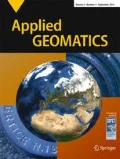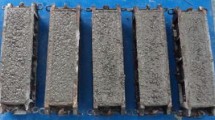Abstract
Visual condition survey and inspection is typically the initial method employed in the assessment of concrete damaged by fire, and it is among the most significant non-destructive testing methods. In spite of visual inspection being simple in principle, it is capable of providing cardinal information about the condition of the fire-damaged structure and act as a basis upon which subsequent and detailed assessment methods can be founded. When concrete is exposed to various elevated temperatures, it undergoes change in its physical characteristics among others, and indicators such as change in surface texture, cracks, spalling and colour change become evident. These indicators of fire-damaged concrete can be assessed using visual inspection methods and further assessed with more advanced methods in a case where detailed investigations are needed. In this study, visual inspection of terrestrial laser scanner data of fire-damaged concrete was investigated by modelling and analysing laser intensity. An analysis of the generated intensity images from laser intensity data has proved useful and valuable in the visual inspection of concrete before and after heating. Furthermore, laser scanner geometric data has been used in the assessment of concrete surface roughness before and after heating.













Similar content being viewed by others

References
Annerel E, Taerwe L (2009) Revealing the temperature history in concrete after fire exposure by microscopic analysis. Cem Concr Res 39(12):1239–1249
Annerel E, Taerwe L (2011) Methods to quantify the colour development of concrete exposed to fire. Constr Build Mater 25(10):3989–3997
Bitenc M, Lindenbergh R, Khoshelham K, van Waarden AP (2010) Evaluation of a laser land-based mobile mapping system for monitoring sandy coasts. International Archives of Photogrammetry, Remote Sensing and Spatial Information Sciences 38(Part 7B):92–97
Buckley SJ, Kurz TH, Scheider D (2012) The benefits of terrestrial laser scanning and hyperspectral data fusion products. International Archives of Photogrammetry, Remote Sensing and Spatial Information Sciences 34(B7):541–546
Büyüköztürk O, Rhim HC (1997) Radar imaging of concrete specimens for non-destructive testing. Constr Build Mater 11(3):195–198
Carrea D, Abellan A, Humair F, Matasci B, Derron M, Jaboyedoff M (2016) Correction of terrestrial LiDAR intensity channel using Oren–Nayar reflectance model: an application to lithological differentiation. ISPRS J Photogramm Remote Sens 113:17–29
Chew MYL (1993) The assessment of fire damaged concrete. Build Environ 28(1):97–102
Colombo M, Felicetti R (2007) New NDT techniques for the assessment of fire-damaged concrete structures. Fire Saf J 42(6–7):461–472
Ergün A, Gokhan K, Serhat BM, Mansour M (2013) The effect of cement dosage on mechanical properties of concrete exposed to high temperatures. Fire Saf J 55:160–167
Felicetti R (2004) Digital camera colorimetry for the assessment of fire-damaged concrete. In: Gambarova PG, Felicetti R, Meda A, Riva P (eds) Proceedings of the workshop, fire design of concrete structures, what now? What next? Milan University of Technology, Milan, pp 211–220
Felicetti R (2013) Assessment methods of fire damages in concrete tunnel linings. Fire Technol 49(2):509–529
Garlock M, Paya-Zaforteza I, Kodur V, Gu L (2012) Fire hazard in bridges: review, assessment and repair strategies. Eng Struct 35:89–98
Georgali B, Tsakiridis PE (2005) Microstructure of fire-damaged concrete. A case study. Cem Concr Compos 27(2):255–259
Gomez DD, Butakoff C, Ersbøll E, Carstensen JM (2007) Automatic change detection and quantification of dermatological diseases with an application to psoriasis images. Pattern Recogn Lett 28(9):1012–1018
Gosain NK, Drexler RF, Choudhuri D (2008) Evaluation and repair of fire-damaged buildings, structural forensics—investigation structures and their components (on-line). http://www.structuremag.org/wp-content/uploads/2014/08/C-STRForensics-Fire-Gosain-Sept081.pdf. Accessed on 12.05.2014
Hager I (2013) Colour change in heated concrete. Fire Technol 50:945–958
Hancock CM, Roberts GW, Bisby L, Cullen M, Arbuckle J (2012) Detecting fire-damaged concrete using laser scanning. FIG Working Week 2012, Rome, Italy, May 6–10
Hussain M, Chen D, Cheng A, Wei H, Stanley D (2013) Change detection from remotely sensed images: from pixel-based to object-based approaches. ISPRS J Photogramm Remote Sens 80:91–106
Ingham J (2009) Forensic engineering of fire-damaged structures. Proceedings of Institution of Civil Engineers 162:CE5
Kaasalainen S, Jaakkola A, Kaasalainen M, Krooks A, Kukko A (2011) Analysis of incidence angle and distance effects on terrestrial laser scanner intensity: search for correction methods. Remote Sens 3(10):2207–2221
Leica Geosystems (2012) HDS7000 User Manual. http://hds.leica-geosystems.com Accessed on 14th July 2014
Luo HL, Lin DF (2007) Study the surface colour of sewage sludge mortar at high temperature. Constr Build Mater 21(1):90–97
Mukupa W, Roberts GW, Hancock CM, Al-Manasir K (2016a) A review of the use of terrestrial laser scanning application for change detection and deformation monitoring of structures. Surv Rev:1–18
Mukupa W, Roberts GW, Hancock CM, Al-Manasir K (2016b) A non-destructive technique for health assessment of fire-damaged concrete elements using terrestrial laser scanning. J Civ Struct Heal Monit 6(4):665–679
Olsen MJ, Kuester F, Chang BJ, Hutchinson TC (2010) Terrestrial laser scanning-based structural damage assessment. J Comput Civ Eng 24(3):264–272
Rasband WS (2016) ImageJ, U. S. National Institutes of Health. Bethesda, Maryland, USA. http://imagej.nih.gov/ij/. Accessed on 11th Apr 2016
Short NR, Purkiss JA, Guise SE (2001) Assessment of fire damaged concrete using colour image analysis. Constr Build Mater 15(1):9–15
Soudarissanane S, Lindenbergh R, Menenti M, Teunissen P (2009) Incidence angle influence on the quality of terrestrial laser scanning points. International Archives of Photogrammetry, Remote Sensing and Spatial Information Sciences 38(3/W8):183–188
Teza G, Galgaro A, Moro F (2009) Contactless recognition of concrete surface damage from laser scanning and curvature computation. NDT & E International 42(4):240–249
Zoller + Fröhlich (2013) Z+F laser control software user manual. Zoller + Fröhlich GmBH, Wangen im Allgäu
Acknowledgements
The authors express their gratitude to the University of Nottingham Ningbo China for the research facilities which made this study to be undertaken. This work is partially supported by “GIS-BIM application in green built environment” innovation team under grant Ningbo Science and Technology Bureau (2015B11011) and also supported by the Ningbo Science and Technology Bureau as part of the Project “Structural Health Monitoring of Infrastructure in the Logistics Cycle” (2014A35008). Many thanks also to the FIG Foundation for the scholarship of the PhD student.
Author information
Authors and Affiliations
Corresponding author
Rights and permissions
About this article
Cite this article
Mukupa, W., Hancock, C., Roberts, G. et al. Visual inspection of fire-damaged concrete based on terrestrial laser scanner data. Appl Geomat 9, 143–158 (2017). https://doi.org/10.1007/s12518-017-0188-9
Received:
Accepted:
Published:
Issue Date:
DOI: https://doi.org/10.1007/s12518-017-0188-9



